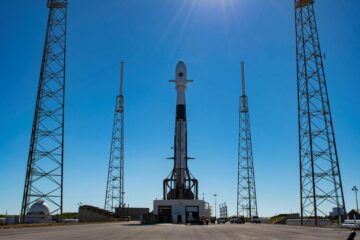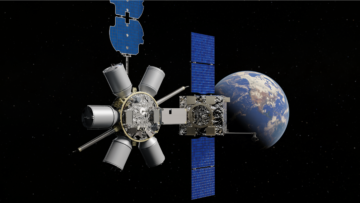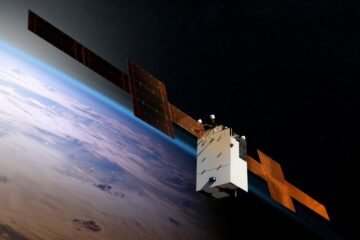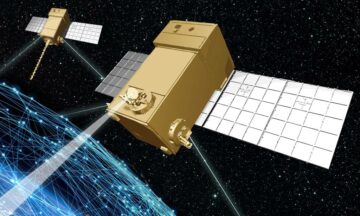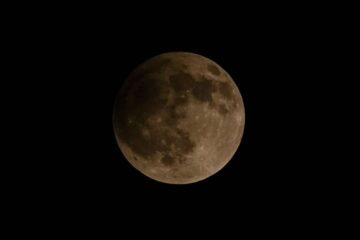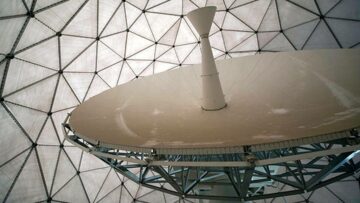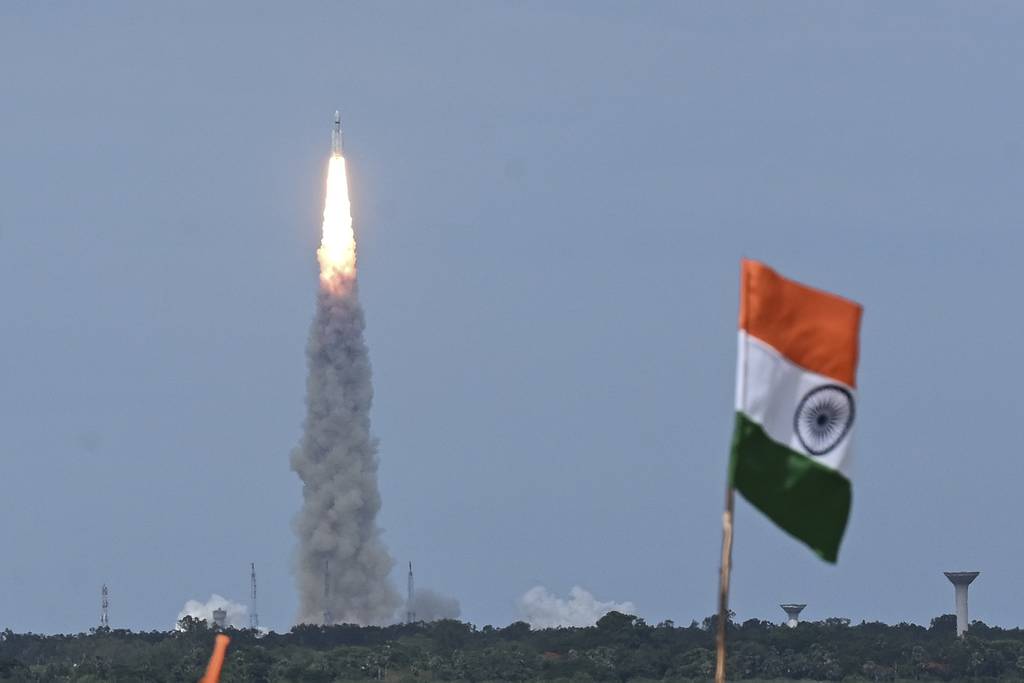
CHRISTCHURCH, New Zealand — India plans to spend about $3 billion on space-related contract awards over the next few years to reduce its dependence on foreign satellites and bolster its counter-space capabilities, according to the head of the military.
Gen. Anil Chauhan’s call to close the gap between India’s own capabilities and other nations that are developing countermeasures in space comes amid tension with China. The neighbors have clashed over a shared border area in the eastern Ladakh region, with both sides in 2020 suffering casualties. In August 2023, Indian Prime Minister Narendra Modi met with Chinese President Xi Jinping to discuss the unresolved border issue and try to deescalate the situation.
Speaking at the DEFSAT conference, held Feb. 7-9 in New Delhi, Chauhan called for greater investment in India’s military space sector and noted the military has already signed five contracts with the private sector, with four more being drawn up. In addition, the government plans to spend 250 billion Indian rupees — or about $3 billion — on contract awards over the next few years, he added.
“It’s the right time for the private industry to utilize this opportunity,” Chauhan said. “Our leadership has envisioned big targets for the nation, from space augmentation to space exploration.”
Sino-Indian space race
During his speech, Chauhan outlined several areas of focus for India’s space sector. First, he called for an indigenous constellation of intelligence, surveillance and reconnaissance satellites equipped with optical and hyperspectral sensors.
Next, he said, the military cannot remain dependent on foreign constellations for positioning, navigation and timing requirements.
“We should also be investing in launch on-demand capabilities in the near future. As the national requirements of ISR, PNT and communication grow, this will resultantly increase the number of Indian satellites orbiting the space, [thus requiring the need for] securing these particular assets, which will require space situational awareness.”
To fill these gaps, the general recommended high-speed satellite communications, a satellite-based internet of things and robust, ground-based infrastructure.
“Lastly, when we are developing all this, I think we need to look at counter-space capabilities, which nations are developing, as a means of deterrence. And maybe this would be required in [the] future to safeguard our assets. In order to ensure that these capabilities are rightfully utilized, doctrinal and connected concepts need to be developed,” he added.
Indeed, there is an inequality in China’s space-based assets compared to those of India. According to the “Military Balance” report released in February by the International Institute of Strategic Studies, China operates 245 military satellites, compared to India’s 26. China also has a reusable spacecraft and counter-space technology, the London-based think tank found.
China is certainly interested in dominating the space domain in terms of control and denying access to adversaries, according to Malcolm Davis, a senior analyst focused on space and Chinese military modernization at the Australian Strategic Policy Institute.
“They’re also developing the counter-space capabilities to threaten U.S. and allied satellites and developing sophisticated launch capabilities that are moving much more toward reusable launch vehicles, heavy-lift and encouraging the growth of commercial space,” he told Defense News. “So in every sense of the word, I think the Chinese are determined to overtake the U.S. in space.”
India is a major ally of the United States, whose own Defense Department warned last year of China’s rise in space capabilities. Its report last year asserted more than 290 systems made up China’s ISR satellite fleet.
“The PLA [People’s Liberation Army] owns and operates about half of the world’s ISR systems, most of which could support monitoring, tracking, and targeting of U.S. and allied forces worldwide, especially throughout the Indo-Pacific region. These satellites also allow the PLA to monitor potential regional flashpoints, including the Korean Peninsula, Taiwan, Indian Ocean, and the SCS [South China Sea],” the report noted.
For example, China has dozens of Yaogan-class satellites in orbit, with 54 dedicated to ISR and another 46 providing electronic or signals intelligence, per IISS data, gathered as late as November.
On Dec. 15, China launched the large Yaogan-41 optical satellite into geostationary orbit. There are also about five Huoyan-1 early warning satellites, and China is testing a quantum-enabled communications satellite that could lead to virtually unbreakable communications.
Beijing’s progress in space, including the creation of its Strategic Support Force in 2015, which is responsible for nearly all PLA space operations, shows “forward thinking,” said David Stupples, an expert in space-based systems and professor at City, University of London.
“China [has] a very agile military, and they follow the latest trends very quickly,” he said, comparing the nation to the U.S. and NATO, which have historically focused more on kinetic capabilities. “Warfare has changed a lot over the last four to five years: Whereas it was 90% kinetic and 10% electronic warfare, it’s now probably 50% to 60% electronic warfare and 40% kinetic.”
China also has its own facsimile of GPS. Known as BeiDou, this constellation has 45 satellites, with the final system launched in June 2020 to provide positioning accuracy at up to 5 meters (16 feet).
China is also developing counter-space capabilities through direct-ascent technology, co-orbital systems, electronic warfare, cyberattacks and directed-energy weapons. These can deny access to and operations in the space domain.
“What you’re seeing is that while the Chinese are developing [these] sort of direct-ascent, kinetic-kill anti-satellite [technology], the favored capability for them will be soft-kill systems that are either co-orbital or ground-based because they can deliver reversible, scalable effects, and they also don’t create clouds of space debris,” Davis said.
Asked whether China has interfered with foreign satellites, Davis said he hasn’t heard of “actual attacks so far, but what they’re demonstrating — perfecting — is the technological means to do these sort of attacks in a crisis leading up to war, to exploit the gray zone attack using, for example, a dual-role commercial satellite that has an anti-satellite capability.” (Gray zone military activities fall below the level of traditional armed conflict.)
China reportedly has multiple ground-based lasers that can disrupt, degrade or damage satellites, with the Pentagon describing the technology as a “current limited capability.”
“They do have lasers powerful enough at the moment probably to destroy a satellite in low Earth orbit,” Stupples concurred. “But they’re also developing satellite-killer satellites, which will go alongside another satellite and then aim a laser at the solar panels or antennas.”
China demonstrated its counter-space work with an anti-satellite test against a defunct weather satellite in 2007. It has continued to launch multiple anti-satellite missiles, like the SC-19 used in 2007, proving Beijing can target systems both in low-Earth and geosynchronous orbits. And in 2018, Lt. Gen. Robert Ashley, then-director of the U.S. Defense Intelligence Agency, warned China was working on the ability to jam satellites from the ground.
Stupples said while the anti-satellite threat is “very serious,” any attack would lead to fratricide due to the likelihood of American retaliation. “What China has then said is: ‘OK, you can do all of that, but we will flood space with our signals intelligence satellites and our reconnaissance satellites, etc., and therefore we’ll make it very difficult to do that.’”
Other notable Chinese capabilities include three tests of a reusable spaceplane and the fielding of transportable, quick-response, solid-fueled space launch vehicles. These could help the PLA rapidly reconstitute its low-Earth orbit capabilities by launching replacement satellites.
China’s commercial constellations also benefit the government, Stupples noted. For instance, Beijing is working on its Guo Wang constellation that could include 13,000 satellites for widespread internet coverage — a concept similar to the Starlink network created by American firm SpaceX. The state-owned company SatNet is to operate this massive constellation.
Juliana Suess, an analyst with the British think tank Royal United Services Institute, wrote in an article that “there are many reasons why China would build a satellite-enabled internet constellation in LEO,” not least of which is to expand its influence overseas.
“The existing strides that China has made in terms of soft power, specifically on the continent of Africa and with regard to internet infrastructure, suggest a relatively fast and easy plug-in into Guo Wang,” she noted.
Playing catchup
In comparison, India’s space efforts, historically headlined by the Indian Space Research Organisation, appear rather modest. But the country has achieved notable feats, including the July 14 launch of the Chandrayaan-3 mission into orbit, which then successfully landed on the moon.
M. Matheswaran, a retired Indian Air Force air marshal, told Defense News the major drivers for India’s focus on space are the 1999 Kargil War, fought against Pakistan over disputed territory, and China’s 2007 anti-satellite test. The Indian government eventually created its tri-service Defence Space Agency in 2019.
“Now the government has brought out a new space policy opening up the space segment to the private sector,” said Matheswaran, who leads The Peninsula Foundation, an India-based think tank. “India is on the right track now to meeting both its civilian and military requirements, but the pace is not going to be comparable to China’s.”
“There are startups that are doing well, and ISRO [Indian Space Research Organisation] is supporting them as well. That needs to be accelerated, which can only be achieved by adequate government and funding support,” he added. “I suppose India will close the gap, but catching up with where China is today is going to take a long time.”
Stupples agreed India is “a long way behind,” citing a lack of research and funding for military space initiatives. “India has the capability of launching satellites,” he said, “but it doesn’t have the impetus to develop this further. Its thinking is more like America’s — you know, kinetic.”
Last year, the Indian government released a space policy to encourage developments in the domestic space sector through private participation. And in February 2024, the government approved a more liberal foreign direct investment policy to attract investors to the industry.
ISRO also announced plans for 30 space launches by March 2025; that’s compared to an average of about three annually in recent years, Matheswaran said.
Meanwhile, China plans to execute about 100 space launch missions this year, according to the state-run Xinhua news agency.
Among India’s private sector, Tata Advanced Systems has emerged as a key player, with local media reporting it can build up to 24 LEO satellites annually. And the startup GalaxEye Space plans to launch its Drishti satellite this year equipped with synthetic aperture radar and multiple sensors to perform multispectral imaging.
The Indian military is also eyeing December for the launch of its GSAT-7R communications satellite for the Navy, reportedly followed by a 2026 deployment of the GSAT-7B that will provide the Army with its first dedicated communications satellite.
India is increasing its navigation capabilities with the so-called NavIC system; that constellation is to grow from seven satellites to 11 within the next five years. A decade later, the government hopes to have 26 satellites in operation to give India a GPS equivalent.
But among India’s production efforts are destructive aims. In 2019, the country test-fired an anti-satellite weapon that destroyed a low-Earth orbit satellite and resulted in additional space debris. Modi said the test was “not against anyone.”
However, Matheswaran said the experiment was meant “to send a message to the rest of the world, particularly to China, because they did it in 2007.″ He said the move exhibited India’s “capability to protect our assets in space, [showing] we have the ability to interfere with your assets in space as well.”
He agreed with Chauhan that India is overly reliant on foreign sources for surveillance data. “When it comes to security-related issues, India cannot depend on that alone for our entire capability. There’s no substitute for creating your complete independence in that capability from other countries, and therefore this is an urgent requirement.”
In January, India and France signed a memorandum of understanding covering satellite launches and space exploration initiatives. The collaboration is expected to lead to a joint constellation of surveillance satellites focused on the Indian Ocean within four years.
They key here is collaboration rather than dependence, Matheswaran said.
“Down the line, it should result in joint training, joint research and development and joint work, including industrial partnerships,” he said. “That’s the way to go.”
Gordon Arthur is an Asia correspondent for Defense News. After a 20-year stint working in Hong Kong, he now resides in New Zealand. He has attended military exercises and defense exhibitions in about 20 countries around the Asia-Pacific region.
- SEO Powered Content & PR Distribution. Get Amplified Today.
- PlatoData.Network Vertical Generative Ai. Empower Yourself. Access Here.
- PlatoAiStream. Web3 Intelligence. Knowledge Amplified. Access Here.
- PlatoESG. Carbon, CleanTech, Energy, Environment, Solar, Waste Management. Access Here.
- PlatoHealth. Biotech and Clinical Trials Intelligence. Access Here.
- Source: https://www.defensenews.com/space/2024/03/06/india-plans-to-spend-3-billion-on-space-can-it-catch-up-to-china/
- :has
- :is
- :not
- :where
- $3
- $UP
- 000
- 1
- 10
- 100
- 13
- 14
- 15%
- 16
- 1999
- 2%
- 20
- 2007
- 2015
- 2018
- 2019
- 2020
- 2021
- 2023
- 2024
- 2025
- 2026
- 23
- 24
- 245
- 250
- 26
- 27
- 30
- 4
- 45
- 46
- 5
- 54
- 6
- 7
- 70
- 9
- a
- ability
- About
- accelerated
- access
- According
- accuracy
- achieved
- activities
- added
- addition
- Additional
- address
- adequate
- advanced
- Aerospace
- africa
- After
- against
- agency
- agile
- agreed
- aim
- aims
- AIR
- Air Force
- All
- allow
- Ally
- alone
- alongside
- already
- also
- American
- Amid
- among
- an
- analyst
- and
- announced
- Annually
- Another
- antenna
- any
- anyone
- appear
- approved
- ARE
- areas
- armed
- Army
- around
- Arthur
- AS
- asia
- Assets
- At
- attack
- Attacks
- attract
- Aug
- AUGUST
- Australian
- average
- awards
- awareness
- BE
- because
- behind
- Beijing
- being
- below
- benefit
- between
- Big
- Billion
- bolster
- border
- both
- Both Sides
- British
- brought
- build
- but
- by
- call
- called
- CAN
- cannot
- capabilities
- capability
- carrying
- Catch
- catching
- Center
- certainly
- changed
- China
- Chinas
- chinese
- citing
- City
- civilian
- Close
- Cms
- collaboration
- comes
- commercial
- Communication
- Communications
- company
- comparable
- compared
- comparing
- comparison
- complete
- component
- concept
- concepts
- Conference
- conflict
- connected
- continent
- continued
- contract
- contracts
- control
- could
- countries
- country
- coverage
- covering
- create
- created
- Creating
- creation
- crisis
- cryogenic
- cyberattacks
- damage
- data
- David
- Davis
- decade
- December
- dedicated
- defence
- Defense
- Defense Department
- defunct
- Delhi
- deliver
- demonstrated
- demonstrating
- Department
- depend
- dependence
- dependent
- deployment
- describing
- destroy
- destroyed
- determined
- develop
- developed
- developing
- Development
- developments
- DID
- difficult
- direct
- dish
- Disrupt
- do
- Doesn’t
- doing
- domain
- Domestic
- dominating
- Dont
- dozens
- drawn
- drivers
- due
- Early
- earth
- eastern
- easy
- effects
- efforts
- either
- Electronic
- emerged
- encourage
- encouraging
- engineer
- Engines
- enough
- ensure
- Entire
- envisioned
- equipped
- Equivalent
- especially
- etc
- eventually
- Every
- example
- execute
- exercises
- exhibited
- Exhibitions
- existing
- Expand
- expected
- experiment
- expert
- Exploit
- exploration
- Facility
- Fall
- family
- far
- FAST
- favored
- Feb
- February
- Feet
- few
- fill
- final
- Firm
- First
- five
- FLEET
- flood
- Focus
- focused
- follow
- followed
- For
- Force
- Forces
- foreign
- found
- Foundation
- four
- France
- from
- fully
- functioning
- funding
- further
- future
- gap
- gaps
- gathered
- Gen
- General
- Give
- Go
- going
- gordon
- Government
- gps
- gray
- greater
- Ground
- Group
- Grow
- Growth
- had
- Half
- Have
- he
- head
- heard
- Held
- help
- here
- his
- historically
- Hong
- Hong Kong
- hopes
- HTML
- HTTPS
- i
- image
- images
- Imaging
- in
- include
- Including
- Increase
- increasing
- independence
- india
- Indian
- indian government
- industrial
- industry
- Inequality
- influence
- Infrastructure
- initiatives
- inside
- instance
- Institute
- Intelligence
- interested
- interfere
- International
- Internet
- internet of things
- into
- investing
- investment
- Investors
- ISRO
- issue
- issues
- IT
- ITS
- January
- Jinping
- joint
- jpg
- July
- june
- Key
- Know
- known
- Kong
- Korean
- kumar
- Lack
- large
- laser
- lasers
- Last
- Last Year
- Late
- later
- latest
- launch
- launched
- launches
- launching
- lead
- Leadership
- leading
- Leads
- least
- LEO
- Level
- liberation
- like
- likelihood
- Limited
- Line
- London
- Long
- long time
- Look
- Lot
- Low
- made
- major
- make
- MAKES
- manufacturing
- many
- March
- massive
- maybe
- means
- meant
- meeting
- Memorandum
- memorandum of understanding
- message
- met
- Military
- minister
- missiles
- Mission
- missions
- modernization
- modest
- moment
- Monitor
- monitoring
- Moon
- more
- most
- move
- moving
- much
- multiple
- Mumbai
- narendra modi
- nation
- National
- Nations
- Navigation
- Near
- nearly
- Need
- needs
- neighbors
- network
- New
- New Zealand
- news
- next
- no
- notable
- noted
- November
- now
- number
- ocean
- of
- off
- on
- On-Demand
- only
- opening
- operate
- operates
- operation
- Operations
- Opportunity
- optical
- or
- Orbit
- orbiting
- order
- organisation
- Other
- our
- out
- outlined
- over
- overseas
- own
- owns
- Pace
- Pakistan
- panels
- participation
- particular
- particularly
- partnerships
- parts
- pentagon
- people’s
- per
- perfecting
- perform
- plans
- plant
- plato
- Plato Data Intelligence
- PlatoData
- player
- policy
- positioning
- potential
- power
- powerful
- president
- Prime
- prime minister
- private
- private sector
- probably
- Production
- Professor
- Progress
- protect
- provide
- providing
- proving
- quickly
- radar
- rapidly
- rather
- reasons
- recent
- recommended
- reduce
- regard
- region
- regional
- relatively
- released
- remain
- remote
- replacement
- report
- reportedly
- require
- required
- requirement
- Requirements
- research
- research and development
- resides
- responsible
- REST
- result
- resulted
- reusable
- reversible
- right
- Rise
- Rival
- ROBERT
- robust
- rocket
- royal
- s
- safeguard
- Said
- satellite
- satellites
- scalable
- SEA
- sector
- securing
- seeing
- seen
- segment
- Senate
- send
- senior
- sense
- sensors
- serious
- Services
- several
- she
- should
- showing
- Shows
- Sides
- signals
- signed
- similar
- situation
- So
- so Far
- Soft
- solar
- solar panels
- sophisticated
- sort
- Sources
- South
- Space
- space exploration
- space-based
- spacecraft
- SpaceX
- specifically
- speech
- spend
- starlink
- startup
- Startups
- state-owned
- States
- Strategic
- strides
- studies
- Successfully
- suffering
- suggest
- support
- Supporting
- suppose
- surveillance
- synthetic
- system
- Systems
- Taiwan
- Take
- tank
- Target
- targeting
- targets
- technological
- Technology
- terms
- territory
- test
- tested
- Testing
- tests
- than
- that
- The
- the world
- Them
- then
- There.
- therefore
- These
- they
- things
- Think
- think tank
- Thinking
- Third
- this
- this year
- those
- threat
- threaten
- three
- Through
- throughout
- Thus
- time
- timing
- to
- today
- told
- toward
- track
- Tracking
- traditional
- Training
- Trends
- try
- u.s.
- understanding
- United
- United States
- university
- urgent
- used
- using
- utilize
- utilized
- Vehicles
- very
- via
- virtually
- wang
- war
- warned
- warning
- was
- watches
- Way..
- we
- Weapons
- Weather
- WELL
- What
- when
- whereas
- whether
- which
- while
- WHO
- whose
- why
- widespread
- will
- with
- within
- Word
- Work
- working
- works
- world
- world’s
- worldwide
- would
- wrote
- xi
- xi jinping
- year
- years
- you
- Your
- Zealand
- zephyrnet
- zone



